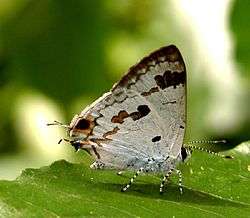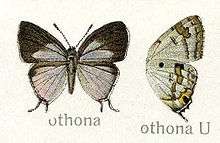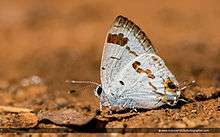Chliaria othona
| Orchid tit | |
|---|---|
 | |
| Scientific classification | |
| Kingdom: | Animalia |
| Phylum: | Arthropoda |
| Class: | Insecta |
| Order: | Lepidoptera |
| Family: | Lycaenidae |
| Genus: | Chliaria |
| Species: | C. othona |
| Binomial name | |
| Chliaria othona (Hewitson, 1865). | |
| Synonyms | |
|
Chliaria eltola Hewitson [1] | |
The orchid tit, Chliaria othona[2][3] is a species of lycaenid or blue butterfly found in Asia.
Orchid Tit is one of the rare butterflies belonging to the family Lycaenidae (Kehimkar, 2008). This butterfly is fairly common in Northern India, but was reported to be very rare in Southern India. In India, Chliaria othona is distributed in the Western Ghats, Uttaranchal to Arunachal Pradesh, the Northeast, West Bengal and Andaman Islands. It was also reported from Nepal, Bhutan, Bangladesh and Myanmar. Orchid Tit prefers wet forests of up to 1524 meters altitude from the mean sea level and occasionally visits damp patches for mud puddling.[4] The caterpillars of Orchid tit feed on the flower buds and flowers of orchids,[5][6] and hence the name.
Description

The orchid tit is a small butterfly which has a wingspan of 24 to 27 mm. The butterfly has two tails, one is 4 mm long at v1 and the other 2 mm long at v2.
- UP:
- Male: The butterfly is pale blue above with three-fifths of the apex black. The apex and the costa of the HW are more narrowly black.
- Female: The female butterfly is brown in colour above with whitish lower part of the disc. The tornal area of the HW is very pale blue with serrated black markings.
- UN: Both sexes are white below with black-edged brown markings and bars at end cell. The FW has a discal band which is broken around v4 and which is broader above the break. There is a prominent black costal spot above the mid-cell. The HW also has a discal band broken in 4 and 6 with a prominent black spot towards the base of 7.The butterfly also has prominent orange-crowned tornal spots.[7]
 Chliaria Othona or Orchid Tit © www.indianwildlifephotographer.com
Chliaria Othona or Orchid Tit © www.indianwildlifephotographer.com
Distribution

The orchid tit is found in Bangladesh[8] India, Myanmar, Thailand, Laos, North Vietnam, Peninsular Malaysia, Pulau Tioman and possibly Taiwan.[2]
In Inda the butterfly is found in the Western Ghats, the Himalayas from Garhwal to Assam, Bengal and onto Myanmar.[2]
In Sikkim, the orchid tit is found up to an altitude of 5000 ft.[7]
Status
Rare in South India. Not Rare in the North.[7]
Habits
_on_Oxalis_orientalis_at_Jayanti%2C_Duars%2C_West_Bengal_W_IMG_5630.jpg)
The orchid tit is to be found in dense, rainy jungles. It is rarely seen except around its food plants - the flower buds of epiphytic orchids. It flies weakly and settles on flowers, leaves. It visits damp patches.[7]
Life cycle
Caterpillar - Green onisciform larvae with red dorsal band and three red rippled lines on each side. The caterpillar's head is concealed and its body is covered with minute bristles. Distinct short protuberances extend from the anal segment. It feeds on the flowers of the orchid.[9]
Pupa - Smooth and greenish-grey, resembles those of other Lycaenidae spp. It has a few white markings, with a distinctly wavy pattern on the wing covers. It is found fastened along the stem of the orchids.[9]
Larval food plants - The orchid tit's larval host plants are from the family Orchidaceae from genus Arundina, Dendrobium, Papilionanthe, Phaius, Phalaenopsis, Spathoglottis and the specific species are Papilionanthe subulata and Spathoglottis plicata [10]
Cited references
- ↑ Evans, W.H. (1932). The Identification of Indian Butterflies (2nd ed.). Mumbai, India: Bombay Natural History Society.
- 1 2 3 Card for Chliaria othona in LepIndex. Accessed 31 July 2007.
- ↑ Markku Savela's website on Lepidoptera. Page on genus Chliaria.
- ↑ Mathew, George (2011). A Handbook on the Butterflies of Nilgiri Biosphere Reserve (PDF). Thrissur: KFRI Research Report.
- ↑ Kehimkar, Issac (2008). The book of Indian butterflies. Bombay: Bombay Natural History Society.
- ↑ C.P., Arjun (2013). "Occurrence of the Oriental Orchid Tit Butterfly (Chliaria othona Hewitson) in the Wayanad Wildlife Sanctuary , Kerala". Malabar Trogon. 13 (1-3): 31 – via Researchgate.
- 1 2 3 4 Wynter-Blyth, Mark Alexander (1957). Butterflies of the Indian Region. Bombay, India: Bombay Natural History Society. p. 353. ISBN 978-8170192329.
- ↑ http://www.prothom-alo.com/bangladesh/article/787585/অপ্সরীর-খোঁজে
- 1 2 Haribal, Meena (1992). The Butterflies of Sikkim Himalaya and Their Natural History. Gangtok, Sikkim, India: Sikkim Nature Conservation Foundation. p. 107.
- ↑ HOSTS - a Database of the World's Lepidopteran Hostplants (http://www.nhm.ac.uk/research-curation/projects/hostplants/) accessed on September 12, 2007.
See also
References
- Beccaloni, George; Scoble, Malcolm; Kitching, Ian; Simonsen, Thomas; Robinson, Gaden; Pitkin, Brian; Hine, Adrian; Lyal, Chris. "The Global Lepidoptera Names Index (LepIndex)". Natural History Museum, London. Retrieved 2016-10-15.
- Evans, W.H. (1932). The Identification of Indian Butterflies (2nd ed.). Mumbai, India: Bombay Natural History Society.
- Haribal, Meena (1992). The Butterflies of Sikkim Himalaya and Their Natural History. Gangtok, Sikkim, India: Sikkim Nature Conservation Foundation.
- "Markku Savela's website on Lepidoptera".
- Wynter-Blyth, Mark Alexander (1957). Butterflies of the Indian Region. Bombay, India: Bombay Natural History Society. ISBN 978-8170192329.
External links
| Wikimedia Commons has media related to Chliaria othona. |